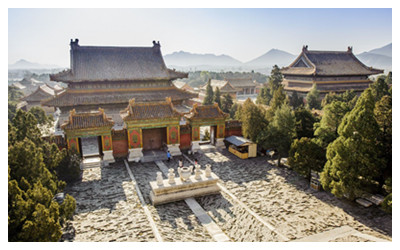Skype: neodalle-travel
Tel: +86 135 7447 2266
E-mail: sales@visitaroundchina.com
 Qing Eastern Tombs, located in Zunhua City, Hebei Province, is 125 kilometers to the east of Beijing, 150 kilometers to the north of Tianjin and 100 kilometers to the northwest of Tangshan. It is the largest, most complete and best arranged Qing Dynasty imperial mausoleum.
Qing Eastern Tombs, located in Zunhua City, Hebei Province, is 125 kilometers to the east of Beijing, 150 kilometers to the north of Tianjin and 100 kilometers to the northwest of Tangshan. It is the largest, most complete and best arranged Qing Dynasty imperial mausoleum.The tomb area is surrounded by mountains in four sides and water in three sides. To the north of Changrui Mountain, it is called “back dragon” and the source of dragon vein; to the south of the mountain it is called “front circle”, also the venue for the tombs that cover an area of 80 square kilometers. There are five emperors’ tombs, four for the queens, five for the concubines and one princess tomb. The tomb gardens surrounds the Shunzhi Emperor’s Filial Piety Tomb and are made up of buildings like wall, Long’en Gate, Long’en Palace, the supporting palace, the Bright Tower and the Treasure Top.
The Bright Tower is the tallest building within which there is an inscribed stone inside with the posthumous title of the tomb owner in Manchu, Mongolian and Han characters. The Treasure Top behind the Bright Tower is an enclosed large grave mound. From the stone archway in the southern end to the Treasure Top in the north, there stretches a 5000 meter long stone tomb passage which is 12 meters wide. The passage has along its length the Big Red Gate, Check Room Palace, Big Gateway and 18 pairs of stone animals. Of these, 6 pairs are animal figures, three pairs are of civil and military officials, one archway bridge, a dragon and phoenix gate and so on.
Here 161 members of the Qing Dynasty were interred, including 5 emperors ( the first emperor of Qing Dynasty Shunzhi, Emperor Kangxi who stayed the longest in his reign, and Emperor Qianlong who has the longest life span), 15 empresses (including the first empress from the Qing Dynasty and Empress Cixi who ruled over China for 48 years), 136 concubines, 3 princes and 2 princesses. People say that you can learn the history of the Qing Dynasty by visiting the Eastern Qing Tombs and an expert of world cultural heritage said that this is“ an innovative and genius masterpiece by humans”.
 Ask Questions ?
Ask Questions ?